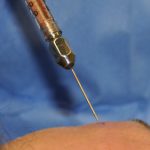Stem cells are the rage in medicine and their potential application for cosmetic changes is no exception. Since fat has become discovered as a resplendid source of stem cells, it has become relatively easy to acquire one’s stem cells from liposuction harvests and grow them in great numbers. As a result, numerous private laboratories have emerged offering stem cell growth and storage. This has led to numerous doctors across the country offering so-called stem cell cosmetic procedures and injections.
The appeal of stem cells therapies to potentially improve aging, wrinkles and sagging tissues is understandably irresistable. But one of the stark realities of stem cells is that no one knows what they will actually do if implanted. While the understanding of the basic biology of stem cells is well known, how they interact with other cells and materials after being implanted is far from an exact science. There are presumed to have remarkable regenerative properties, but there is not one single scientific paper that has ever actually shown that to be true in human application. Quite frankly, stems cell for cosmetic applications in humans is really an experiment even if it is the patient’s own grown cells that is being used.

While the injectable filler used was not identified in this report it undoubtably was Radiesse, a particulated filler that contains calcium hydroxyapatite particles as part of its composition. The stem cell treatment appears to have been a concoction of Radiesse and stem cells with the theory presumably being that it would improve the longevity of the filler’s effects. What was not predicted was that some of the hydroxyapatite particles served as a nidus for stem cell conversion into bone. In hind sight, this potential reaction seems obvious. But the euphoria of using stem cells and the lack of any previous studies using this combination led to this one patient’s unprecedented iatrogenic affliction.
It is important for patients to understand that the FDA has not approved any cosmetic procedures which use stem cells…or at least so claims. The more common and widely popular use of fat injections undoubably contains stem cells but their incorporation into the injectable treatment is inadvertent and the stem cells are not altered. Extracting stem cells and isolating and manipulating them for re-injection for human cosmetic alteration is now unapproved and requires a controlled FDA-regulated study in which to do it.
Whether stem cells are the fountain of youth for humans, or at least offers some spot areas of physical improvement, will now await years of further study.
Dr. Barry Eppley
Indianapolis, Indiana


